Hadramout Region
Hadramout region[lower-alpha 1] (Arabic: إقليم حضرموت, romanized: Iqlimu Hadhramawt), is the largest of the six Federal Regions of Yemen that is expected to be activated in the next constitution, to be a federal autonomous region in eastern Yemen. The Hadramout region includes four Yemeni “Wilayat” or States, which are Hadramout, Al-Mahrah, Shabwah and Socotra, with its capital being the city of Al-Mukalla.[1] Some of the people of Al-Mahrah governorate reject the decision of mixing them with the Hadramout region and demand the establishment of a region of their own.[2][3][4]
Hadramout Region
إقْليمُ حضْرَموت | |
|---|---|
Federal Region | |
| The Federal Region of Hadramout | |
 Flag  Seal | |
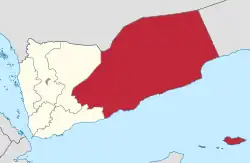 | |
| Country | |
| Capital city | Mukalla |
| States | Hadramout Al Mahrah Shabwah Socotra |
| Government | |
| • Type | Federal Autonomous Parliamentary |
| Area | |
| • Total | 359,944 km2 (138,975 sq mi) |
| • Rank | 1st |
| Population | |
| • Total | 1,863,000 |
| • Rank | 1st |
| Demonym | Hadhrami / Hadharem |
| Time zone | UTC+3 |
| Area code | +967 |
| ISO 3166 code | YE-HD |
Etymology
The Greeks and Romans mentioned Hadramout with some distortion. Eratosthenes referred to it as (Latin: Chatramotitae) and the writers of the Old Testament referred to it as (Hebrew: חֲצַרְמָוֶת Hazar maveth), literally meaning court of death.[5] It is mentioned as the third son of Qahtan and the brother of Sheba[6]
And to Eber were born two sons: the name of one was Peleg, for in his days the earth was divided, and his brother's name was Joktan. Joktan begot Almodad, Sheleph, Hazarmaveth, Jerah, Hadoram, Uzal, Diklah, Obal, Abimael, Sheba, Ophir, Havilah, and Jobab. All these were the sons of Joktan
— Genesis 10:26
History

The Kingdom of Hadramout existed before the birth of Christ, but its exact start cannot be confirmed. Its capital was Arabian Arma' and it was not far from the city of Teman (the capital of the Kingdom of Qataban).[7] It was a tribal federation consisting of several tribes united by their common veneration of the god Sin. Hadramout was originally the name of one of the tribes. The mention of Hadramout and its god Sin is found in the inscription of Surwah by the Makrib Sabean writer Karib'il Watar I around 700–680 BCE.
The Kingdom, led by King Shahr-al-Khuraymat, formed an alliance with the Kingdom of Ma'in and the Kingdom of Qataban and became independent from the Kingdom of Sheba around 330 BCE, during which the Himyarite dynasty ruled the Kingdom of Sheba.[8][9] The relationship between the Kingdom of Hadramout and the Himyarite Kingdom remained tense, with both sides waging wars against each other for control of the trade routes and territory in the region.[10]
In the 2nd century CE, Hadramout was known for its frankincense and myrrh trade.[11] The incense trade route (southern incense route) that passed through the southern part of Hadramout helped the region flourish economically and culturally.[12] The Kingdom of Hadramout played a significant role in connecting the cultures of Arabia, Mesopotamia, East Africa, and the Roman Empire.[13]
Islamic History
In the 7th century, Islam spread to Hadramout, and it was gradually integrated into the Caliphate. The region played a role in Islamic history during the Rashidun Caliphate and the Umayyad Caliphate. In the 11th century, the Hadramout region came under the rule of the Mahdids, who were of Banu Hadhrami origin.[14] They established the Qasimi dynasty, which ruled the region for several centuries.[15]
Portuguese and Ottoman Influence
In the 16th century, the Portuguese arrived in Hadramout and established several settlements along the southern coast.[16] However, their influence was short-lived as the Yemeni Imams managed to drive them out by the 17th century.[17] Subsequently, Hadramout came under Ottoman influence, and the Ottomans maintained control over the region until the early 20th century.[18]
Modern History


The Qu'aiti sultans ruled the vast majority of Hadramout, under a loose British protectorate, the Aden Protectorate, from 1882 to 1967, when the Hadramout was annexed by South Yemen. The Qu'aiti dynasty was founded by Umar bin Awadh al-Qu'aiti, a Yafa'i tribesman whose wealth and influence as hereditary Jemadar of the Nizam of Hyderabad's armed forces enabled him to establish the Qu'aiti dynasty in the latter half of the 19th century, winning British recognition of his paramount status in the region in 1882. The British Government and the traditional and scholarly sultan Ali bin Salah signed a treaty in 1937, appointing the British government as "advisors" in Hadramout. The British exiled him to Aden in 1945, but the Protectorate lasted until 1967.[citation needed]
In 1967, the former British Colony of Aden and the former Aden Protectorate including Hadramaut became an independent Communist state, the People's Republic of South Yemen, later the People's Democratic Republic of Yemen. South Yemen was united with North Yemen in 1990 as the Republic of Yemen.
The capital and largest city of Hadramout is the port Mukalla. Mukalla had a 1994 population of 122,400 and a 2003 population of 174,700, while the port city of Ash Shihr has grown from 48,600 to 69,400 at the same time. One of the more historically important cities in the region is Tarim. An important locus of Islamic learning, it is estimated to contain the highest concentration of descendants of the Prophet Muhammad anywhere in the world[19]
Geography
Historical Hadramout is the region located between longitudes 45 to 56 east of Greenwich and latitudes 13 to 19 north of the equator, encompassing the boundaries of Greater Hadramout from Shabwah in the west to the ancient city of Dhofar in the east, bordered by the Arabian Sea in the south and the sands of Al-Ahqaf in the north. It includes the following areas: Abyan, Al-Dhale, Yafa, Upper Aulaqi, Lower Aulaqi, Awadli, Bihan, Hadramout Plateau, Wadi Hadramout, Mehra Tribe Territory, and Dhofar. The boundaries of Central Hadramout lie between the sands of Al-Ahqaf to the north and the Arabian Sea to the south and between Ain Bamabad to the west and Ras Suqutra to the east. The boundaries of Lesser Hadramout: Some historians have given the name Hadramout to the main Wadi Hadramout, which is inside Hadramout and is defined from Al-Aqad in the west to the Shab Nebi Allah in the east.
Terrain
The governorate is characterized by the diversity of its terrain into three main sections:
The first section: Mountainous regions concentrated in the central and southwestern parts and some western parts.
The second section: Desert regions concentrated in the northern, northwestern, and eastern parts of the governorate.
The third section: Coastal regions represent the coastal strip overlooking the Arabian Sea. In addition to that, there are many scattered valleys in various parts of the governorate. Furthermore, there is Socotra Island and many other affiliated islands.[20]
Climate
The climate of the Hadramout region is diverse and varies from one governorate to another, and even within the same areas of some governorates, especially in the vast Hadramout Governorate. Along the coastal areas of Hadramout Governorate, a coastal climate prevails, with hot summers and mild winters. In the mountainous areas, the climate is moderate in summer and cold in winter. The desert areas have a desert climate with hot and dry weather throughout the year.[21]
Government
Languages and dialects
Several languages are spoken in the Hadramout region, including Arabic as the official language, Mahri, Socotri, and the Hadhrami dialect.
Economy
Oil and gas
A Soviet discovery in the southern governorate of Shabwah has proven only marginally successful even when taken over by a different group. A Western consortium began exporting oil from Masila in the Hadhramaut in 1993, and production there reached 67,000 m3/d (420,000 bbl/d) in 1999. There are new finds in the Jannah (formerly known as the Joint Oil Exploration Area) and east Shabwah blocks. Yemen's oil exports in 1995 earned about US$1 billion. Yemen's offshore oil and gas deposits are estimated to contain billions of barrels of oil and gas. Marib oil contains associated natural gas. In September 1995, the Yemeni Government signed an agreement that designated TotalEnergies of France to be the lead company for a project for the export of liquefied natural gas (LNG). In 1997, Yemen Gas Company joined with various privately held companies to establish Yemen LNG (YLNG). In August 2005, the government gave final approval to three LNG supply agreements, enabling YLNG to award a $2 billion contract to an international consortium to build the country's first liquefaction plant at Balhat on the Arabian Sea coast. The project is a $3.7 billion investment over 25 years, producing approximately 6.7 million tons of LNG annually, with shipments likely to go to the United States and South Korea. Production of LNG began in October 2009. The Yemen government expects the LNG project to add $350 million to its budget and enable it to develop a petrochemicals industry.[22]
Hadramout produces approximately 258.8 thousand barrels per day.[23] One of the prominent oil fields is the Masila Basin Sector (14), discovered in 1993. The Yemeni government is committed to developing its oil fields to increase oil production, aiming to enhance national wealth in response to the country's economic and social development needs. Oil contributes between 30% and 40% of the gross domestic product (GDP) value and represents more than 70% of the total general budget revenues of the state. Moreover, it constitutes more than 90% of the country's export value.[24]
Agriculture
Hadramout
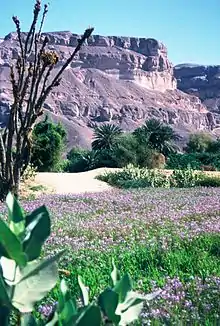
The vegetation in the governorate varies according to the surface diversity and the prevailing climate. It can be categorized as follows:
Vegetation
The mountainous regions are covered with various types of perennial trees such as acacia, tamarisk, and juniper. They also contain wild herbs and shrubs, including chamomile, thyme, and lavender.[25]
In the coastal areas, there are coconut palms, banana trees, and other types of tropical vegetation. Date palms are also widespread in the region.[26]
Environment
The Socotra archipelago forms an independent marine ecological system. The island is one of the four most important islands in the world in terms of plant biodiversity. It is home to thousands of plants, animals, and resident birds. It is also the main habitat for the famous frankincense trees that were prominent in ancient times. The island is home to nine species of frankincense trees out of the 25 known species worldwide.
Around 850 species of plants have been recorded on the island, with approximately 270 species being endemic to Socotra and not found anywhere else in the world. Among the important and valuable species is the Dragon's Blood Tree. The island is also home to ten rare and endangered plant species out of the 18 worldwide.
The northwestern part of the Gulf of Aden and the surrounding area of the Socotra archipelago are among the most productive marine areas in the world, comparable in productivity to the coasts of Peru and West Africa.
The island hosts important bird species at the global level, with 291 species, 44 of which breed on the islands, while 58 species migrate regularly. Some of these species are endangered. Socotra's marine life is characterized by a significant diversity, including 352 species of coral reefs, 730 species of coastal fish, and 300 species of mollusks, crabs, and lobsters.
Vegetation

Socotra Island is home to 850 species of plants, with 270 of them being endemic, meaning they exist only on the island and nowhere else in the world. The island also harbors ten extremely rare and threatened plant species, seven of which are listed as critically endangered in the International Union for Conservation of Nature's Red List.
Socotra Island is known for its abundant vegetation, with approximately 750 plant species. Among these are several medicinal plants used in traditional medicine to treat various ailments. These include the Socotra Aloe, Frankincense trees, Myrrh, and the dragon blood tree. Other commonly used medicinal plants on the island include Gras, Ivorb, and others. Additionally, there are other rare plants on the island, including the widespread presence of the "Amat" tree. The island is also characterized by dense palm tree forests that are found in many places, particularly along the banks of perennial water streams, creating a beautiful artistic scene with the green carpet merging with the blue sea surrounding the island.
Some of the notable rare trees and plants on Socotra Island include the Dragon's Blood Tree, the Desert Rose, the Amat tree, the Kartab plant, the "Iksha" tree, Socotra Aloe: Tayf, the Qamham plant, the Wild Pomegranate (Rahini – Sbryhr), and the Isheb plant.
Culture
Architecture & Tourism
Hadramout region has significant tourism potential due to its historical and cultural heritage. The ancient city of Shibam, known as "the Manhattan of the Desert," is a UNESCO World Heritage Site. It is famous for its high-rise mud-brick buildings and has attracted tourists from around the world.[27] Other notable tourist attractions in the region include the historic towns of Tarim and Seiyun, the Wadi Hadramout with its lush palm groves, and the traditional mud-brick architecture found throughout the region.
Mukalla
Mukalla, a coastal city in the Hadhramaut region, is distinguished by its notable Hadhrami architecture. The city's buildings exhibit intricate facades adorned with geometric patterns, reflecting local craftsmanship. Minarets with delicate latticework rise gracefully, reflecting a blend of architectural and spiritual significance. Mukalla's urban design features narrow alleys and courtyard houses, showcasing adaptation to the arid climate and fostering community interaction. The use of indigenous materials further emphasizes its connection to the local context.
.jpg.webp) Sultan Al-Quaiti Palace, Mukalla. now a Museum
Sultan Al-Quaiti Palace, Mukalla. now a Museum.jpg.webp) Mukalla, Yemen
Mukalla, Yemen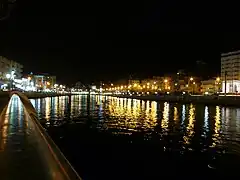 Al-Khor, Mukalla
Al-Khor, Mukalla
Tarim
Tarim, a historically significant city renowned for its Islamic scholarship, boasts a distinctive Hadhrami architectural character. Its structures showcase meticulous craftsmanship, with filigree patterns adorning facades and minarets. The urban layout of Tarim promotes communal living through interconnected alleyways and courtyard houses. The city's minarets, an architectural hallmark, contribute to its skyline, symbolizing its cultural and religious heritage.[28]
Nestled within Yemen's Hadramaut Valley, Tarim holds a cherished status as an architectural gem within Islamic heritage. Its strategic position along historic caravan routes has propelled it to the forefront, earning the distinction of Islamic Capital of Culture in 2010. This accolade has ignited collaborations in architectural preservation, education, science, culture, and communication among Islamic nations.[28]
Embodying a spiritual legacy, Tarim boasts a remarkable concentration of descendants of Prophet Muhammad. This spiritual resonance finds expression in its distinctive architecture, with mud-crafted marvels adorning the town's landscape. Among these standouts, Yemen's loftiest mud minaret and the celebrated Al-Mihdhar minaret showcase Tarim's finesse in mud construction.[28]
The fragility of these architectural treasures, vulnerable to weathering, has spurred fervent preservation efforts. Tarim's new cultural capital status has become a driving force behind initiatives to protect and restore its delicate mud-built structures.[28]
Though sometimes overshadowed by its association with the bin Laden family, Tarim seeks to redefine its narrative. As the Islamic Cultural Capital, Tarim's architectural splendor beckons a new era of appreciation, igniting interest in its thousand-year architectural journey. With aspirations to cultivate a thriving tourist industry, Tarim envisions a future where its architectural heritage stands as a testament to Islamic artistic ingenuity on the global stage.[28]
Shibam
Shibam, which is now a UNESCO World Heritage Site, is known for its distinct architecture. The houses of Shibam are all made out of mudbrick, and about 500 of them are tower blocks, which rise 5 to 11 stories high,[29] with each floor having one or two rooms.[30] This architectural style was used in order to protect residents from Bedouin attacks.[31] While Shibam has been in existence for an estimated 1,700 years, most of the city's houses originate from the 16th century. Many, though, have been rebuilt numerous times in the last few centuries.
Shibam is often called "the oldest skyscraper city in the world".[32] It is one of the oldest and best examples of urban planning based on the principle of vertical construction.[33] The city has some of the tallest mud buildings in the world, with some of them over 30 m (98 feet) high,[34] thus being early high-rise apartment buildings. In order to protect the buildings from rain and erosion, the walls must be routinely maintained by applying fresh layers of mud. The city is surrounded by a fortified wall,[33] giving it the name "the walled city of Shibam".
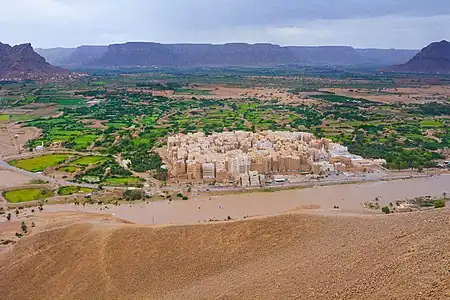 View of Shibam
View of Shibam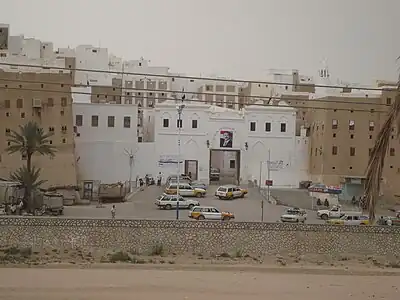 City gate
City gate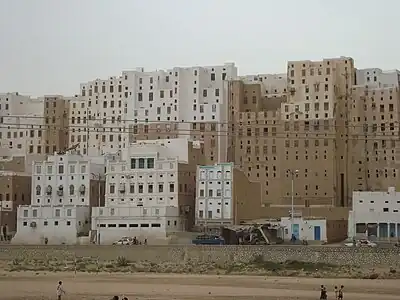 View of some "skyscrapers"
View of some "skyscrapers"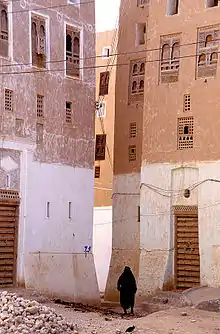 Two buildings on a street inside the town
Two buildings on a street inside the town.jpg.webp) Street view
Street view.jpg.webp) Architecture pattern
Architecture pattern Shibam buildings with balconies
Shibam buildings with balconies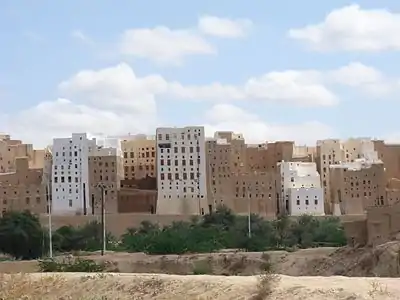 View of Old Walled City of Shibam
View of Old Walled City of Shibam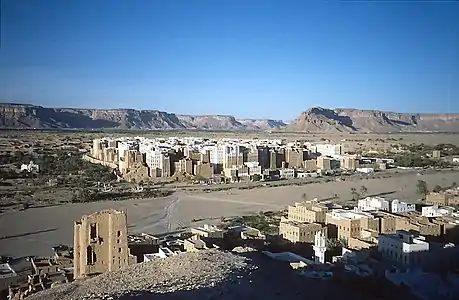 View of Shibam
View of Shibam
Habban
Habban, an ancient city nestled within the Shabwa governorate, boasts a distinct architectural legacy characterized by ingenious mud and straw construction techniques. Notable features include towering mud structures with intricate carvings, reflecting both historical significance and artistic flair. Habban's architecture showcases a blend of utilitarian functionality and aesthetic charm. The enduring mud buildings stand as a testament to the city's enduring history, while its diverse architectural styles, including palaces, mosques, and tombs, capture the city's cultural tapestry. Rooted in Yemeni heritage, Habban's architecture is a living embodiment of the intersection between local culture and the built environment, reflecting the city's historical and cultural significance.[35]
Media
Administrative Divisions and Population
| # | Governorate | Area (km2) | Population |
|---|---|---|---|
| 1 | Hadramaut Governorate | 189,382 | 1,028,556 |
| 2 | Socotra Governorate | 3,650 | 44,120 |
| 3 | Shabwah Governorate | 42,584 | 536,594 |
| 4 | Al Mahrah Governorate | 67,297 | 101,701 |
| Total | 302,913 | 1,710,971 | |
See also
Notes
- Also Hadramaut Region, Hadhramaut Region or Hadramawt Region
References
- صحافة نت | "بالاسماء"الرئيس هادي يعلن رسمياً اليمن دولة اتحادية من 6 أقاليم Archived 2017-09-04 at the Wayback Machine
- "باكريت يرفض ظم المهرة الى حضرموت والبحسني ينسحب". 2020-06-14. Retrieved 2020-06-28.
- "اليمن الآن". 2020-06-14. Retrieved 2020-06-28.
- "ردفان برس". 2020-06-14. Retrieved 2020-06-28.
- Dictionary.Com Archived March 5, 2016, at the Wayback Machine
- Book of Genesis, Chapter 10, verse 26
- Naval Western Arabia & The Red Sea p.224 Routledge, 2013 ISBN 978-1-136-20995-6
- Holger Gzella Languages from the World of the Bible p.162 Walter de Gruyter, 2011 ISBN 978-1-934078-63-1
- Woodard The Ancient Languages of Syria-Palestine and Arabia p.145 Cambridge University Press ISBN 978-1-139-46934-0
- Leonard & Brunschvig The Encyclopaedia of Islam Vol. II, p.183 ISBN 978-90-04-05745-6
- Robin Arabia and the Arabs: From the Bronze Age to the Coming of Islam p.281 Routledge, 2017 ISBN 978-1-134-64634-0
- Miller Arabic Geography in the Ninth and Tenth Centuries p.37 Indiana University Press, 1999
- Gazetteer of the Persian Gulf, Oman, and Central Arabia p.953 Government of India, 1908
- The Isma'ilis: Their History and Doctrines by Farhad Daftary, p. 237
- The Isma'ilis: Their History and Doctrines by Farhad Daftary, p. 239
- The Indian Ocean in the Making of Early Modern India by Pius Malekandathil, p. 115
- The Indian Ocean in the Making of Early Modern India by Pius Malekandathil, p. 115
- The Indian Ocean in the Making of Early Modern India by Pius Malekandathil, p. 114
- https://www.newstatesman.com/200710180041.
{{cite web}}: Missing or empty|title=(help) - "نبذة تعريفية عن محافظة حضرموت". yemen-nic.info. Archived from the original on 16 May 2022. Retrieved 2022-05-21.
- Climate of Hadhramaut Archived July 28, 2017, at the Wayback Machine
- Yemen country profile. Library of Congress Federal Research Division (December 2006). This article incorporates text from this source, which is in the public domain.
- U.S. Energy Information Administration Archived March 3, 2016, at the Wayback Machine
- CIA World Factbook Archived February 9, 2018, at the Wayback Machine
- Vegetation in Hadhramaut Archived July 28, 2017, at the Wayback Machine
- Vegetation in Hadhramaut Archived July 28, 2017, at the Wayback Machine
- Ancient City of Shibam Archived August 9, 2018, at the Wayback Machine
- Yemeni town named cultural capital, retrieved 2023-08-14
- Helfritz, Hans (April 1937). "Land without shade". Journal of the Royal Central Asian Society. 24 (2): 201–16. doi:10.1080/03068373708730789.
- Jerome, Pamela; Chiari, Giacomo; Borelli, Caterina (1999). "The Architecture of Mud: Construction and Repair Technology in the Hadhramaut Region of Yemen". APT Bulletin. 30 (2–3): 39–48 [44]. doi:10.2307/1504639. JSTOR 1504639.
- Morrison, Alastair M.; Coca-Stefaniak, J. Andres (27 August 2020). Routledge Handbook of Tourism Cities. Routledge. ISBN 9780429534805 – via Google Books.
- "Wadi Hadramowt and walled city of Shabam". ShibamOnline.net. Retrieved 3 January 2010.
- Old Walled City of Shibam, UNESCO World Heritage Centre
- Shipman, J. G. T. (June 1984). "The Hadhramaut". Asian Affairs. 15 (2): 154–162. doi:10.1080/03068378408730145.
- مدينة حبان: محافظة شبوة اليمنية: اكتشف عاصمة الدولة الواحدية وسبب ازدهار اليمن قديماً, retrieved 2023-08-14
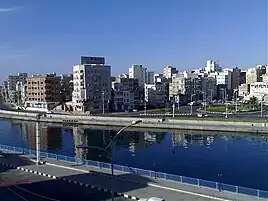
.jpg.webp)
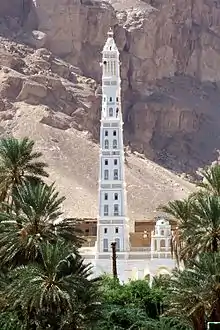

.jpg.webp)
.jpg.webp)
.jpg.webp)
.jpg.webp)



